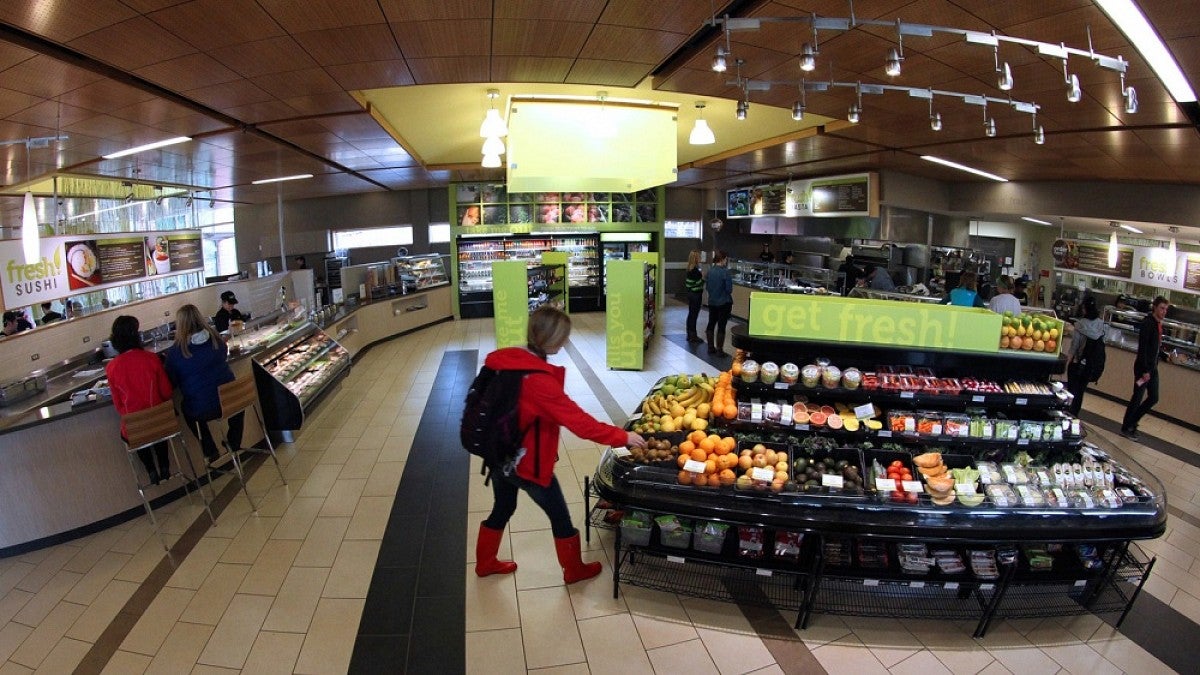If you’ve used a bike lane or crosswalk at the University of Oregon, enjoyed stir-fry in one of the dining halls, rented skis from the Outdoor Program or simply refilled a water bottle on campus, you’ve been a part of the UO’s nationally recognized Healthier Campus Initiative.
The UO is one of 32 colleges and universities awarded the honor this year by Partnership for a Healthier America, an organization developed in 2010 by then-first lady Michelle Obama.To be recognized as a Healthier Campus Initiative partner, the institution commits to meeting 23 of 41 health- and sustainability-related guidelines within three years.
The University Health Center collaborated with University Dining and other departments and divisions across campus to bring healthy food options to dining facilities and implemented a variety of wellness programs to spark a culture shift toward healthy living.
Deb Beck, executive director of the health center, traveled to a conference in Chicago in early April to accept the award on behalf of the UO.
“This honor is a great illustration of collaboration,” Beck said. “About 85 percent of the metrics were dietary related. It also involved pedestrian and bike safety, access to exercise and recreation, and wellness programming at the Duck Nest.”
The Duck Nest, located in the Erb Memorial Union, was a popular topic of conversation at the conference, Beck said. Her peers were intrigued by the concept of an integrated wellness center that focuses on stress reduction, nutrition and self-care activities.
“Most of the people didn’t know about the Duck Nest, so they really took notice.” Beck said. “I think there will be universities in that room who will follow with similar programs of their own.”
One of the national guidelines focuses on local, sustainable food. Based on the 2017 figures reported to Partnership for a Healthier America, the UO purchased more than $900,000 in food and beverages from local farms and producers, about 12 percent of its total dining and catering budget. Those numbers have remained consistent, according to Tom Driscoll, associate director of housing and director of dining services.
“We buy a lot of our food through Hummingbird Wholesale, which represents numerous local, small farms,” Driscoll said. “All of our dairy items are also locally sourced.”
Even the tofu is hometown fresh, Driscoll said, with 15,000 pounds purchased annually from Surata Soy Foods of Eugene.
“Healthy options are definitely a premier component of all of our offerings,” Driscoll said. “Fresh vegetables and fruit are abundant in all of our dining locations, and more non-meat options are being incorporated into the regular menu.”
Healthy eating at the UO makes for a positive domino effect off campus. Food for Lane County picks up unused food from UO Dining’s six kitchens, six days a week, to share with the community.
At times during the implementation process, departments combined forces with outside vendors to find solutions. For instance, take the initiative to switch to compostable service ware.
Dining partnered with the UO Zero Waste Program and Rexius, a local commercial composter. Driscoll said it took some effort to source a product that would work for the composter yet still be durable enough to make it through a meal.
“The first spoon we tried would melt if you were eating soup, so we had to go through some processes to find the right product,” he said.
In looking to the future, Beck said that the UO will be a partner of the Healthier Campus Initiative as long as the university continues to maintain current metrics.
Beck anticipates that Partnership for a Healthier America will consider ways to keep their guidelines relevant, such as addressing growing trends in the use of vape pens, pod systems and recreational marijuana.
“We may not meet all 41 metrics if they are not pertinent to our campus,” Beck said, “but we can still make advances and continue to work together across divisions to partner on the health and well-being of our community.”
—By Colleen Schlonga, Student Services and Enrollment Management


